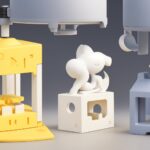3D Printing in Education: Benefits and Applications
3D Printing in Education: Benefits and Applications
Description: An exploration of how 3D printing is transforming education by enhancing STEM learning and providing students with hands-on experiences in technology and design.
Keywords: 3D printing in education, educational benefits of 3D printing, 3D printing for students
Article
How 3D Printing is Transforming Education: Benefits and Applications
The use of 3D printing in education is reshaping how students engage with complex subjects, including STEM (science, technology, engineering, and math). From primary schools to universities, educators are integrating 3D printing into curricula, allowing students to build skills in problem-solving, creativity, and hands-on technology applications.
Key Benefits of 3D Printing in Education
Hands-On Learning
3D printing brings concepts to life, allowing students to engage in hands-on learning by designing, creating, and analyzing tangible models.
For example, students learning geometry can create 3D shapes, while biology classes can print models of cells and organs, making abstract concepts more accessible.
Enhanced STEM Education
Integrating 3D printing for students in STEM subjects provides a unique opportunity to develop critical thinking and design skills.
This technology promotes experimentation, enabling students to iterate on designs and witness firsthand the real-world implications of engineering and technology concepts.
Fosters Creativity and Innovation
With 3D printing, students can design anything they imagine, from art sculptures to functional inventions, fostering creativity and encouraging innovative thinking.
By iterating on designs and experimenting with shapes, sizes, and materials, students build confidence in their problem-solving abilities.
Preparation for the Future Workforce
Learning 3D printing technology prepares students for future careers in fields like engineering, healthcare, architecture, and product design.
Schools that provide 3D printing experiences help students stay competitive in an increasingly technology-driven world.
Applications of 3D Printing in Education
STEM Projects and Prototyping
3D printing in STEM allows students to create models, prototypes, and engineering solutions, bridging the gap between theoretical and practical knowledge.
Art and Design
Art students can create 3D models and intricate sculptures, transforming traditional art projects and introducing them to digital design software.
Many schools now offer courses on 3D design and printing, which inspire new forms of artistic expression and introduce students to potential career paths.
Anatomy and Biology
Medical students can print anatomical models for a realistic look at complex structures, enhancing understanding and offering a hands-on approach to learning anatomy.
3D printed models help biology students visualize cells, organs, and other biological systems, making it easier to grasp complex biological concepts.
Historical Models and Archaeology
History students can recreate artifacts and structures, allowing them to study replicas of archaeological finds, ancient architecture, and historical artifacts.
This application brings history to life and provides an immersive learning experience that traditional teaching methods may not offer.
Mathematics and Geometry
3D printing allows mathematics students to create and study physical representations of geometric shapes, angles, and other mathematical concepts.
These hands-on models enhance students’ spatial reasoning and provide a unique way to approach mathematical problem-solving.
Conclusion
3D printing for students offers countless possibilities for hands-on learning, collaboration, and creative thinking across all grade levels. By incorporating this transformative technology, educators empower students with skills that are valuable in today’s world, from problem-solving to design thinking. The future of 3D printing in education promises exciting advancements that will continue to enhance the learning experience and prepare students for the careers of tomorrow.



